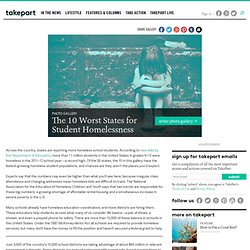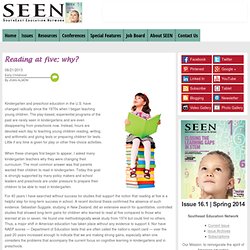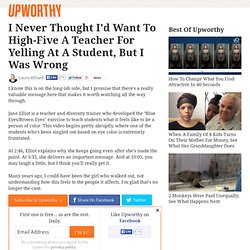

Poverty in the U.S.: The 10 Worst States for Student Homelessness. Idaho may not be the largest state in the union, but it’s one of the top states when it comes to growth in homeless students.

Between the 2010–11 and 2011–12 school years Idaho saw a 27 percent increase in homeless students, a total of 6,076 kids. The reasons for these numbers in Idaho are myriad. Parents often lose jobs, which are already scarce, through layoffs or illness. Eviction follows, and families find themselves homeless on the streets or living in shelters. One local nonprofit, OATHS, was founded by high school student Ben Skinner to help homeless students “get what they need to enjoy, succeed, and stay in school.” Reading at five: Why? For 40 years I have searched without success for studies that support the notion that reading at five is a helpful step for long-term success in school.

A recent doctoral thesis confirmed the absence of such evidence. Sebastian Suggate, studying in New Zealand, did an extensive search for quantitative, controlled studies that showed long-term gains for children who learned to read at five compared to those who learned at six or seven. He found one methodologically weak study from 1974 but could find no others. Thus, a major shift in American education has taken place without any evidence to support it. Nor have NAEP scores — Department of Education tests that are often called the nation’s report card — over the past 20 years increased enough to indicate that we are making strong gains, especially when one considers the problems that accompany the current focus on cognitive learning in kindergartens and in preschools. These goals are more appropriate than most standards I have seen.
I Never Thought I'd Want To High-Five A Teacher For Yelling At A Student, But I Was Wrong. I know this is on the long-ish side, but I promise that there's a really valuable message here that makes it worth watching all the way through.

Jane Elliot is a teacher and diversity trainer who developed the "Blue Eyes/Brown Eyes" exercise to teach students what it feels like to be a person of color. This video begins pretty abruptly, where one of the students who's been singled out based on eye color is extremely frustrated. At 2:46, Elliot explains why she keeps going even after she's made the point. At 3:35, she delivers an important message. And at 10:05, you may laugh a little, but I think you'll really get it. Many years ago, I could have been the girl who walked out, not understanding how this feels to the people it affects. How GERM is infecting schools around the world - The Answer Sheet.
This was written by Pasi Sahlberg, author of “ Finnish Lessons: What Can the World Learn About Educational Change in Finland? And director general of Finland’s Center for International Mobility and Cooperation. He has served the Finnish government in various positions, worked for the World Bank in Washington D.C. and for the European Training Foundation in Italy as senior education specialist. Sahlberg has also advised governments internationally about education policies and reforms. He is also an adjunct professor of education at the University of Helsinki and University of Oulu. What the U.S. can’t learn from Finland about ed reform - The Answer Sheet.
Finland’s high-achieving public school system is now part of the conversation about U.S. education reform these days.

What, it is often asked, can we learn from Finland? (Plenty, actually, though U.S. reformers consistently ignore the lessons.) The query has been asked and answered so often that it seems like a good time to ask what the United States can’t learn from Finland. So I asked Pasi Sahlberg, author of “Finnish Lessons: What Can the World Learn About Educational Change in Finland?”
To tackle the subject, which he does, below. Sahlberg is director general of Finland’s Centre for International Mobility and Cooperation. By Pasi Sahlberg As the United States is looking to reform its public school system, education experts have increasingly looked at other countries for examples on what works and what won’t. Share My Lesson - Free K-12 Resources By Teachers, For Teachers. Do2Learn: Educational Resources for Special Needs. Digitalplayground4ipadlearning - home. 5/15/12 - unconventional education. In today's excerpt - an unconventional approach to education: "In 1999 the Indian physicist Sugata Mitra got interested in education.

He knew there were places in the world without schools and places in the world where good teachers didn't want to teach. What could be done for kids living in those spots was his question. Self-directed learning was one possible solution, but were kids living in slums capable of all that much self-direction? "At the time, Mitra was head of research and development for NIIT Technologies, a top computer software and development company in New Delhi, India.
"The kids who lived in the slums could not speak English, did not know how to use a computer, and had no knowledge of the Internet, but they were curious. Free Technology for Teachers. Professional Learrning. Teacher professional development.